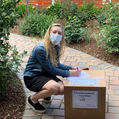top of page
Anchor 1
In mid-late March of 2020, the family of members of our team were directly impacted by COVID-19. We were all going through a difficult time and we wanted to find a way to make a real difference in our community.
01
WORKING WITH MAKERNEXUS

We found MakerNexus, a popular makerspace in our community with an established network for individuals in the Bay Area to print face shields and deliver them to hospitals. We were drawn into making a difference in supporting frontline workers.
A partnership formed between MakerNexus and us, and we became part of their network.
We helped manage some minor logistics for them and we printed ~200 face shields for MakerNexus.

02
BRANCHING OFF
"WE SERVE THE UNDERSERVED"
We noticed that our long-standing philosophy of serving the underserved was not aligning with the philosophy of MakerNexus:
We observed from doctors and nurses we knew that they had an inadequate supply of PPE. Nearly every network was directing face shields to larger hospitals and medical foundations, but not smaller hospitals, front-line businesses, and senior homes.
Despite the great experience we had working under MakerNexus, we branched off, looking to form an initiative of our own, with a similar network to MakerNexus but with a focus on the underserved.
03
RE-DESIGNING
"OUR ROBOTICS EXPERIENCE HAS
REAL-WORLD APPLICATIONS"
.jpg)
During our experience printing for MakerNexus, we found that popular face shield designs were not optimized for efficiency; they took very long to print and required too many resources with dwindling supply chains. We knew that our first step was to create the best possible face shield.
DESIGN GOALS
OUR END
FRONTLINE END
Through 2 weeks, we put to use the experience we learned from designing FTC robots for 3 seasons. We designed our face shields in Fusion 360, manufactured and prototyped the design, found areas for improvement, and repeated.

WE WENT THROUGH
260 SAVED ITERATIONS
&
61 DISTINCT FILES
When we were satisfied with a prototype, we sent a few of them to doctors and nurses at Santa Clara Valley Medical Center to collect feedback. 2 cycles later, it was clear our face shield design met all our goals. It took less than 45 minutes to 3D print face shields, the face shield plastic itself was easy to create from transparent printer film, and top hoods were based off plastic dividers and folders. By using these materials for the plastic protections, we were able to easily source our materials rather than putting even more strain on the dwindling nationwide supply of polycarbonate.
04
PREPARING FOR PRODUCTION
THE ROAD TO 5,000

With only 3 total 3D printers shared between members of the team and a few packs of transparent plastic film, we did not have the production power to produce enough face shields fast enough to make a difference.
To increase our budget, we set up a GoFundMe page, which allowed us to raise $8,000 and spread our initiative, and another $2,000 from direct donations. We increased our total number of 3D printers to 12, through a partnership with MCreate, 2 local middle schools, members in our community, and directly buying printers with our budget.
We set a goal of 5,000 face shields and calculated the amount of material we needed. We directly bought filament for the 3D printers, which was discounted for us by Overture. We also directly bought plastic sheets and elastic bands for the face shields from Office Depot and EBay respectively.
BY THE SUPPORT FROM THE COMMUNITY, WE BOUGHT:
1.4 MILES OF ELASTIC BANDS
12x 3D PRINTERS
11,320x SHEETS OF PLASTIC
300 lbs OF FILAMENT

05
PRODUCTION
We were ready to scale up our production. Every day, we would pick up a bag of shields from under the printer, post-process them, then deliver them. Each printer produced 20 to 30 face shields per day. With 12 total printers and accounting printer malfunctions, we averaged 100-120 face shields a day. Each person was responsible for a material and learned tricks. Technical lessons we learned from robotics were also applied to maximize efficiency.
5,065x FACE SHIELDS DONATED
64x HOSPITALS & FRONTLINE-BUSINESSES SUPPORTED
$14,901.37 WORTH OF MATERIALS SPENT
THANKS, EVERYONE!
-KURIOSITY
bottom of page








